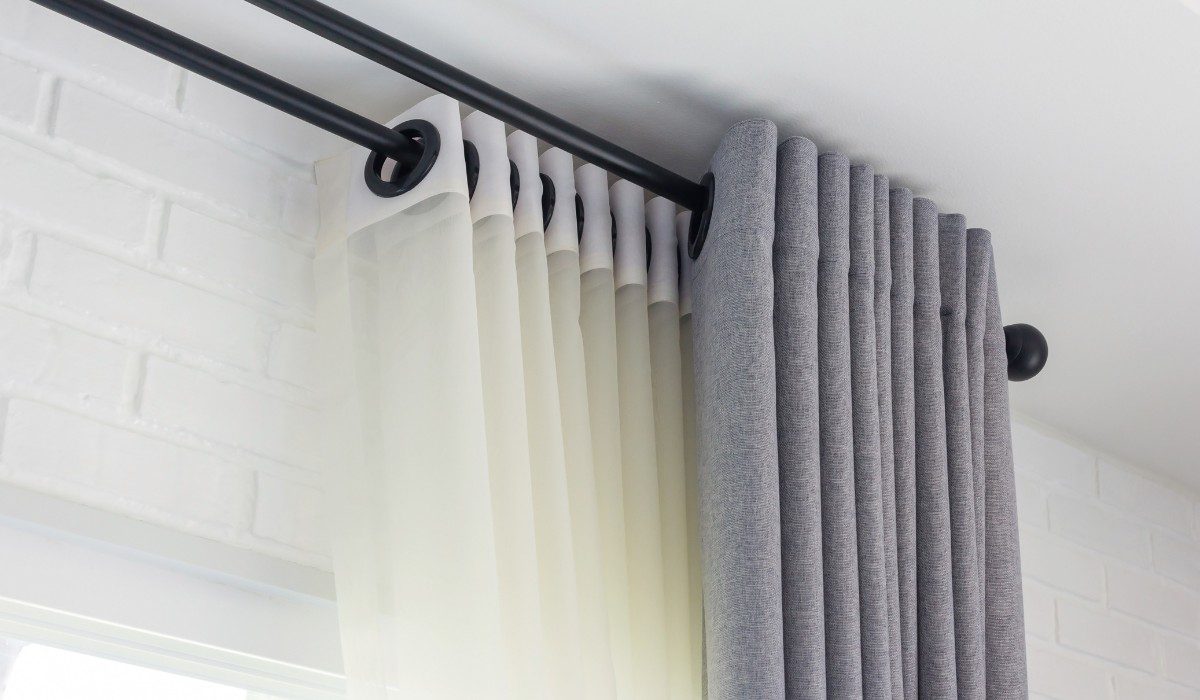Curtains are a necessity in homes owing to both privacy and aesthetic purposes. However, given the variety in types of curtains and hanging mechanisms, hanging them can prove to be quite a task. Such a problem might arise if your curtains are not suitable for the hanging mechanism provided in the house or there is none provided at all. This can also be a problem if you are a tenant and are not allowed to make extensive structural changes to the house. In this article, we will familiarise you with some easy ways to hang curtains that are especially helpful if you reside in a temporary lodging.
See also: How to hang curtains from the ceiling?
Tension rods
Tension rods refer to spring-loaded rods that utilise tension to stay in place between two surfaces. As a result, they don’t require drilling or nails for the installation process. Before installing, make sure to measure the width of your window or the space where the curtains are to be hung to avoid discrepancies with the length of the rod. Next, simply adjust the rod to fit the width and place it between the surfaces. Adjust the tension by turning the rod and double check that it fits snugly between the spaces.
Command hooks
Depending on their size and type, these adhesive hooks have the ability to hold various weights. The surface where you plan to attach the hooks should be cleaned before installation. Just place the hook firmly against the surface and hold for a while. The adhesive takes about an hour to set fully, after which you can go ahead with attaching the curtain rod or tension rod to put up the curtains.
Sticky hooks or adhesive strips
Possessing similar qualities as command hooks, these hooks are available in various shapes and sizes and can be used to hold curtain rods or rings. Prepare the area of installation by cleaning it thoroughly and stick the hooks to the surface, pressing firmly to ensure adhesion. Hang the curtains on the hooks with the help of curtain rods or clips.
Velcro strips
With an adhesive backing on one side and hook-and-loop fasteners on the other, one of the versatile applications of velcro strips include hanging curtains as well. All you need to do is attach one side of the Velcro to the wall or window frame and the other side to the top edge of your curtain. To secure the curtain in place, you just have to press the strips together firmly.
Magnetic curtain rods
As the name suggests, these rods use magnets to attach onto metal surfaces, including metal window frames, thereby making them a convenient option to hang curtains on. Simply placing the rod on the metal surface ensures stability as the magnets hold it in place. Now you just need to hang your curtains on the rod as you would with a traditional rod.
Suction cup hooks
If the surface you plan to hang your curtains on is smooth and non-porous, suction cups can provide the ideal solution. This option provides best adhesion on low-friction surfaces like glass or tiles. After cleaning the surface to remove any loose debris that might affect its smoothness, press the cup against the surface and lock it in place. The curtain rod or clips can be easily attached to the hooks once they are in place.
Over-the-door hooks
By hanging over the top of the door, these hooks provide a place to mount a curtain rod for drapery. They just need to be hung securely in the desired spot in a way that does not damage the door or obstruct its functioning. You can then conveniently attach a curtain rod to the hooks.
Fabric ties
Believe it or not, you can use something as simple as fabric ties to put up your curtains. By attaching them directly to the window frame or wall with adhesive strips or hooks, they can be used to hold curtains in place. Make sure to secure the fabric ties to the strips or hooks well and just tie the curtains using them.
Adjustable curtain rods
These rods are designed especially for the purpose of hanging curtains and can fit into window frames without drilling. Moreover, they can also be adjusted to fit into various window widths. Before installing the rod, you need to measure the width of your window and then extend the rod to the frame. Place it in position and secure according to the manufacturer’s instructions.
Pros and cons
Now that we have gone through all the available options, let’s compare the pros and cons of each to help you make a more informed decision.
| Type | Pros | Cons |
| Tension rods | No tools needed for installation, easy removal, no wall damage | Suitable only for use for lighter curtains and compatible spaces |
| Command hooks | Easy installation and removal, no tools needed, minimal wall damage | Weight limitations subject to the hook type that need to be considered according to your curtain material |
| Sticky hooks or adhesive strips | Easy installation and removal, minimal damage, versatile applications | Cohesion not good on textured surfaces, might have weight limitations |
| Velcro strip | Easy attachment and removal, no hardware needed, neat appearance | Suitable only for lighter materials, might leave behind adhesive stains on removal |
| Magnetic curtain rods | No installation process involved, easy removal, suitable for metal surfaces | Application limited to metal frames or surfaces, not compatible with most window types |
| Suction cup hooks | No permanent installation, easy repositioning, no wall damage | Only suitable for smooth surfaces, decrease in suction strength over time |
| Over-the-door hooks | No wall damage, easy installation and removal, suitable for windows positioned near doorways | High visibility might create visual clutter, might not be suitable for all door types |
| Fabric ties | Simple and inexpensive, easy removal, minimal wall damage | Only suitable for lightweight curtains, overall appearance not as polished |
| Adjustable curtain rods | No tools needed for installation, easy removal, adaptable to different window sizes | Application subject to the weight and design of the rod, not as sturdy as traditional rods |
FAQs
What method should I go for if I want to hang curtains without damaging the walls?
Tension rods and adhesive hooks are ideal for hanging curtains without damaging walls as they do not leave behind marks on removal.
Are tension rods suitable for all curtain types?
Tension rods are best suited for lightweight fabrics, sheer curtains and small to medium-sized windows.
How do I ensure adhesive hooks or strips hold my curtains securely?
Make sure to opt for the variants that are rated for the weight of your curtains, clean the surface for proper adhesion and follow the manufacturer’s instructions carefully.
Which temporary curtain hanging options work on textured walls?
Suction cups or specialised adhesive strips designed for uneven surfaces can be considered. It is recommended to go for tension rods or fabric ties for uneven surfaces as they don’t rely on wall adhesion.
How do magnetic curtain rods work?
Magnetic curtain rods consist of string magnets that attach to metal surfaces and are super easy to install and remove.
Can I use fabric ties for heavier curtains?
Fabric ties are not recommended for heavier curtains or larger windows as they may not support the weight adequately.
What are the ways to hang curtains without making extensive structural changes?
Consider non-invasive methods like tension rods, adhesive hooks or suction cup hooks that do not require drilling or permanent alterations.
| Got any questions or point of view on our article? We would love to hear from you. Write to our Editor-in-Chief Jhumur Ghosh at jhumur.ghosh1@housing.com |







